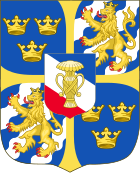
Back Gustav II Adolf Afrikaans Gustav II. Adolf von Schweden ALS Gustavo II Adolfo de Suecia AN Gustaf II Æðelwulf Swēona Cyning ANG غوستاف الثاني أدولف Arabic جوستاف التانى ادولف ARZ II Qustav Adolf Azerbaijani Густаў II Адольф Byelorussian Густаў II Адольф BE-X-OLD Густав II Адолф Bulgarian
| Gustavus Adolphus | |
|---|---|
 Portrait attributed to Jacob Hoefnagel, 1624 | |
| King of Sweden | |
| Reign | 30 October 1611 – 6 November 1632 |
| Coronation | 12 October 1617 |
| Predecessor | Charles IX |
| Successor | Christina |
| Born | 9 December 1594 Castle Tre Kronor, Sweden |
| Died | 6 November 1632 (aged 37) Battle of Lützen near Lützen, Electorate of Saxony, Holy Roman Empire |
| Burial | 22 June 1634 |
| Spouse | |
| Issue | Christina, Queen of Sweden Illegitimate: Gustav of Vasaborg |
| House | Vasa |
| Father | Charles IX of Sweden |
| Mother | Christina of Holstein-Gottorp |
| Religion | Lutheran |
| Signature |  |
| Military career | |
| Allegiance | Sweden |
| Service/ | Swedish Army |
| Battles/wars | |
| Swedish Royalty |
| House of Vasa |
|---|
 |
| Gustav I |
|
| Eric XIV |
| John III |
| Sigismund |
| Charles IX |
|
| Gustavus Adolphus |
|
| Christina |
Gustavus Adolphus (9 December [N.S 19 December] 1594 – 6 November [N.S 16 November] 1632), also known in English as Gustav II Adolf or Gustav II Adolph,[1] was King of Sweden from 1611 to 1632, and is credited with the rise of Sweden as a great European power (Swedish: Stormaktstiden). During his reign, Sweden became one of the primary military forces in Europe during the Thirty Years' War, helping to determine the political and religious balance of power in Europe. He was formally and posthumously given the name Gustavus Adolphus the Great (Swedish: Gustav Adolf den store; Latin: Gustavus Adolphus Magnus) by the Riksdag of the Estates in 1634.[2][3][4]
He is often regarded as one of the greatest military commanders in modern history, with use of an early form of combined arms.[5][6] His most notable military victory was the Battle of Breitenfeld in 1631. With his resources, logistics, and support, Gustavus Adolphus was positioned to become a major European leader,[7] but he was killed a year later at the Battle of Lützen. He was assisted in his efforts by Count Axel Oxenstierna, the Lord High Chancellor of Sweden, who also acted as regent after his death.
Coming to the throne at the age of 16, Gustavus Adolphus inherited three wars from his father Charles IX of Sweden: border conflicts with Russia and Denmark–Norway, and a dynastic struggle with his first cousin, King Sigismund III Vasa of Poland.[8] Of these, the Danish war was the most serious.[9] During his reign, Sweden rose from the status of a Baltic Sea basin regional power to one of the great powers of Europe and a model of early modern era government. Gustavus Adolphus is known as the "father of modern warfare",[10] or the first modern general. He taught a number of other military commanders, such as Lennart Torstensson, who would go on to expand the boundaries and power of the Swedish Empire after Gustavus Adolphus's death. Spoils meant he became a successful bookraider in Europe, targeting Jesuit collections.[11]
His contributions to Sweden's rise in power included reformation of the administrative structure. For example, he began Parish Registration of the population, so that the central government could more efficiently tax and conscript the people.[12] He is also widely commemorated by Protestants in Europe as the main defender of their cause during the Thirty Years' War, with multiple churches, foundations and other undertakings named after him, including the Gustav-Adolf-Werk.[13][14]
- ^ Williamson, David (1988). Debrett's Kings and Queens of Europe. Webb & Bower. pp. 124, 128, 194, 207. ISBN 0-86350-194-X.
- ^ Nils Ahnlund/Michael Roberts Gustav Adolf the Great American-Scandinavian Foundation, New York, 1940
- ^ Anders Fryxell Gustaf II Adolf Norstedts, Stockholm, 1894, p. 435
- ^ Lis Granlund Riddarholmskyrkan, de svenska konungarnas gravkyrka Riksmarskalksämbetet, 1980 ill. p. 14 (GUSTAVUS ADOLPHUS MAGNUS)
- ^ In Chapter V of Clausewitz' On War, he lists Gustavus Adolphus as an example of an outstanding military leader, along with: Alexander the Great, Julius Caesar, Alexander Farnese, Charles XII, Frederick the Great and Napoleon Bonaparte.
- ^ Grant, R.G. (2011). Commanders: History's Greatest Military Leaders. DK Publishing. pp. 144–147. ISBN 978-1-4053-3696-3.
- ^ Stephen J. Lee, Aspects of European History 1494–1789 (2nd ed. 1984), pp. 109–14.
- ^ Svensk Uppslagsbok, 1950,vol 5,column 353, article "Gustav; 2. Gustav II Adolf" Quote: (Swedish) "Av de tre krig, det danska, det ryska och det polska, G. ärvde..." In English "Of the three wars, the Danish, the Russian and the Polish, Gustav II Adolphus inherited...
- ^ Same source, and the quote continues "hotade det första rikets existens". English "... did the first one endanger the existence of the realm."
- ^ Dodge, Theodore Ayrault (1890). Gustavus Adolphus: A History of the Art of War from Its Revival After the Middle Ages to the End of the Spanish Succession War, with a Detailed Account ... of Turenne, Conde, Eugene and Marlborough. Boston and New York: Da Capo Press Inc. ISBN 978-0-306-80863-0. Archived from the original on 19 April 2023. Retrieved 13 December 2015.
- ^ Murray 2009, p. 118.
- ^ T. K. Derry, History of Scandinavia: Norway, Sweden, Denmark, Finland, and Iceland (1979), pp. 110–24.
- ^ Huffman, John (14 March 2022). "Gustavus Adolphus: The Lion of the North". Discerning History. Archived from the original on 17 August 2022. Retrieved 16 July 2022.
- ^ "Gustavus Adolphus". Encyclopedia Britannica. Archived from the original on 14 July 2022. Retrieved 16 July 2022.
© MMXXIII Rich X Search. We shall prevail. All rights reserved. Rich X Search